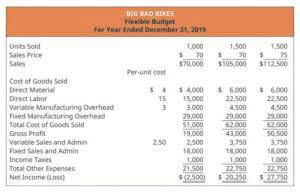
The amount would be added to current assets without any debt added to current liabilities; since current liabilities are short-term, one year or less, and the $40.6 billion in debt is long-term. Below is Exxon Mobil’s (XOM) balance sheet from the company’s annual report for 2022. We can see current assets of $97.6 billion and current liabilities of $69 billion. Shortening your accounts payable period can have the opposite effect, so business owners will want to carefully manage this policy.
- Retailers must tie up large portions of their working capital in inventory as they prepare for future sales.
- Generally speaking, the working capital metric is a form of comparative analysis where a company’s resources with positive economic value are compared to its short-term obligations.
- Working capital during this period is bound to change due to an increase or decrease in the current assets and current liabilities.
- A large positive measurement could also mean that the business has available capital to expand rapidly without taking on new, additional debt or investors.
- For example, if a company experiences a positive change, it may have more funds to invest in growth opportunities, repay debt, or distribute to shareholders.
- The working capital cycle formula is days inventory outstanding (DIO) plus days sales outstanding (DSO), subtracted by days payable outstanding (DPO).
Change in Net Working Capital Calculation Example (NWC)
- If you look at current assets and current liabilities, you will find them on the balance sheet.
- This is a sign of financial health, since it means the company will be able to fully cover its short-term obligations as they come due over the next year.
- As a business owner, it is important to know the difference between working capital and changes in working capital.
- If your net working capital one year was $50,000 and the next year it was $75,000, you would have a positive net working capital change of $25,000.
- Imagine that in addition to buying too much inventory, the retailer is lenient with payment terms to its own customers (perhaps to stand out from the competition).
- The provision for bad debts will be treated as surplus when all debtors are good.
It reflects the fluctuations in a company’s short-term assets and liabilities. It shows how efficiently a company manages its current resources, such as cash, inventory, and accounts payable. Positive changes indicate improved liquidity, while negative changes may suggest financial strain.
- This article explores the key drivers behind changes in working capital and their implications for businesses striving to maintain financial stability and sustainable growth.
- If the Net Working capital increases, we can conclude that the company’s liquidity is increasing.
- Wide swings from positive to negative working capital can offer clues about a company’s business practices.
- The company has a claim or right to receive the financial benefit, and calculating working capital poses the hypothetical situation of liquidating all items below into cash.
- Net working capital, often abbreviated as “NWC”, is a financial metric used to evaluate a company’s near-term liquidity risk.
What is the approximate value of your cash savings and other investments?
- Positive working capital is when a company has more current assets than current liabilities, meaning that the company can fully cover its short-term liabilities as they come due in the next 12 months.
- Generally, the larger your net working capital balance is, the more likely it is that your company can cover its current obligations.
- A company with more operating current assets than operating current liabilities is considered to be in a more favorable financial state from a liquidity standpoint, where near-term insolvency is unlikely to occur.
- For example, if it takes an appliance retailer 35 days on average to sell inventory and another 28 days on average to collect the cash post-sale, the operating cycle is 63 days.
- This measures the proportion of short-term liquidity compared to current liabilities.
- Stronger growth calls for greater investment in accounts receivable and inventory, which uses up cash.
- Net working capital is a liquidity calculation that measures a company’s ability to pay off its current liabilities with current assets.
Second, it can reduce the amount of carrying inventory by sending back unmarketable goods to suppliers. Third, the company can negotiate with vendors and suppliers for longer accounts payable payment terms. Each one of these steps will help improve the short-term liquidity of the company and positively impact the analysis of net working capital. Since Paula’s current assets exceed her current liabilities her WC is positive.
Paying with Checks: Advantages and Disadvantages
Conversely, negative working capital occurs if a company’s operating liabilities outpace change in net working capital the growth in operating assets. This situation is often temporary and arises when a business makes significant investments, such as purchasing additional stock, new products, or equipment. The net working capital (NWC) formula subtracts operating current assets by operating current liabilities.
What Does the Current Ratio Indicate?

On SoFi’s retained earnings balance sheet marketplace, you can shop top providers today to access the capital you need. Understanding changes in cash flow is also important if you are applying for a small business loan. Lenders will often look closely at a potential borrower’s working capital and change in working capital from quarter-to-quarter or year-to-year.

Let us understand the formula that shall act as a basis for us to understand the intricacies of the concept and its related factors. The change in net revenue is the difference between the ending and beginning balance. In the final part of our exercise, the incremental net working capital (NWC) will be calculated and expressed as a percentage.

Retailers must tie up large portions of their working capital in inventory as they prepare for future sales. As a business owner, it is important to know the difference between working capital and changes in working capital. Working capital tells you the level of assets your business has available to meet its short-term obligations at a given moment in time. Change in working capital, on the other hand, measures what is happening over a given period of time with regard to the liquidity of your company. The https://www.bookstime.com/ Change in Net Working Capital (NWC) measures the net change in a company’s operating assets and operating liabilities across a specified period. It is an indicator of operating cash flow, and it is recorded on the statement of cash flows.
To Ensure One Vote Per Person, Please Include the Following Info

Current liabilities encompass all debts a company owes or will owe within the next 12 months. The overarching goal of working capital is to understand whether a company can cover all of these debts with the short-term assets it already has on hand. Ultimately, changes in net working capital impact a company’s cash flow and financial health, highlighting the importance of monitoring these fluctuations for effective financial management. The NWC metric is often calculated to determine the effect that a company’s operations had on its free cash flow (FCF). Aside from gauging a company’s liquidity, the NWC metric can also provide insights into the efficiency at which operations are managed, such as ensuring short-term liabilities are kept to a reasonable level.

Recent Comments